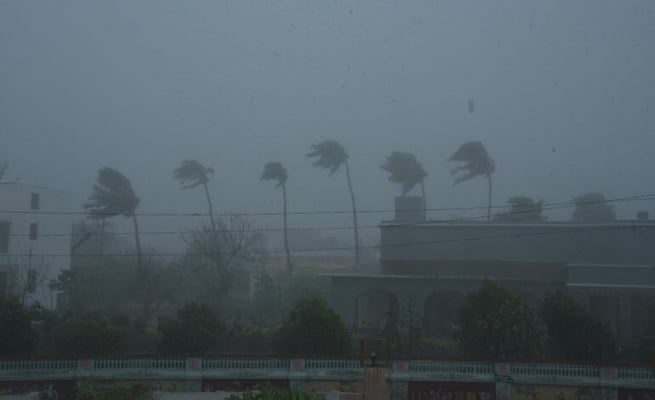Cyclone Fani uproots trees, triggers heavy rains in Bengal & Odisha in India

Cyclone Fani, one of the strongest storms to batter the Indian subcontinent in decades, uprooted trees and triggered rains as it entered West Bengal post-midnight on Saturday, hours after making landfall and causing havoc in Odisha on Friday.
No loss of life or any injury has been reported so far.
According to the Meteorological department, the extremely severe cyclonic storm relatively weakened after entering coastal Odisha and transformed into "very severe" as it approached Bengal.
"The severe cyclonic storm Fani entered Bengal at 12.30 a.m. through Odisha's Balasore. It crossed Kharagpur packing a wind of 70-80 kmph, gusting to 90 kmph," Regional Meteorological Centre's Deputy Director General Sanjib Bandyopadhyay, said.
The storm is now lying close to Arambagh in Hooghly district, and is 40 km west of Kolkata.
"It is likely to continue further in north, north east direction, and reach the east Burdwan-Hooghly border, and through Nadia go to Bangladesh on Saturday afternoon, weakening into a cyclonic storm, after having triggered rains," Bandyopadhyay said.
Fani lashed cities and towns in coastal Bengal including Digha, Mandarmani, Tajpur, Sandehskhali and Contai while the effects of the storm could also be felt in cities like Kharagpur and Burdwan as trees were uprooted and metal hoardings gave way.
Parts of Kolkata and the suburbs also received moderate to heavy rainfall since Friday afternoon.
The epicentre of the storm is expected to hit the city in the early hours on Saturday.
The rains would continue till early Saturday.
In the sea resort of Digha, the win speed reached 70 kmph in some areas, in Frazerganj the wind velocity was between 60 and 70 kmph
Kharagpur has so far recorded 95 mm rainfall, which will continue for the next two to three hours.
"The rains will continue till early morning on Saturday, and the weather will start improving by evening," he said.
The administration has switched off electricity to prevent any accident as the storm passed through a particular point in the state.
Fani strongest cyclone to hit India since 1999: Skymet
India has witnessed at least 20 severe cyclonic storms in past two decades but the ongoing "extremely severe" cyclone "Fani", that hit the eastern coast along Odisha with a wind speed of up to 200 km per hour on Friday, has been found to be the strongest to hit the country since 1999.
Private forecaster Skymet said the Super Cyclone of 1999 had struck the eastern coast with a wind speed of 225-250 kmph, wreaking havoc in Odisha, destructing whatever came in its path.
"After the Super Cyclone of 1999, Fani has been found to be the strongest cyclone to hit India as the wind speed crossed the 200 kmph-mark," Mahesh Palawat, Director at Skymet, told IANS.
Indian Meteorological Department (IMD) chief K.J. Ramesh said that 'Fani' was also the strongest cyclonic storm in the month of April since 1901.
"Also, Fani has been found to have the longest survival cycle. It has lasted too long," Ramesh told media.
There is a glaring difference between the Super Cyclone of 1999 and the current one, as over 10,000 people were killed in the former while casualties have been minimal in the latter, thanks to the technological advancements and the improved disaster management system put in place this time.
"Loss of life should be minimum this time due to the advancement of information system and effective response actions such as evacuation measures and preventive remedies," Ramesh said.
In 2014, over 80 people were killed by Cyclone "Hudhud" which had a wind speed of 200-205 kmph. It was the strongest cyclonic storm since the Super Cyclone of 1999 till Cyclone Fani appeared on the scene.
The death toll had crossed 60 after Cyclone "Titli" pounded Odisha last year with a wind speed of 140-150 kmph gusting to 165 kmph.
"In 1999, we did not have satellite images or Doppler radar. Even if we could get satellite images, they were not accurate. So we could not track the storm or determine the location where it would land. We were not sure about its intensity," Palawat said.
He also appreciated the government agencies for their disaster management efforts in the past few days.
Timely and accurate weather updates, including the movement of Fani, helped authorities execute their disaster management plans effectively.
While two deaths were reported in Odisha on Friday, the damages were largely restricted to uprooting of trees, destruction of crops, disruption of air/road communication, power supply and telecommunication networks and damages to houses.
The cyclone is expected to move north-eastward towards West Bengal with a wind speed of 90-100 kmph gusting to 115 kmph by Friday midnight or early Saturday, triggering moderate to heavy rainfall in the state and the adjoining Bihar and Jharkhand.
After making its landfall on Friday morning, Cyclone Fani started to weaken due to loss of moisture, Palawat said. It means it posed lesser risk to people going forward than it did in the morning.
In Odisha alone, about 10,000 villages and 52 Urban Local Bodies were affected by the cyclonic storm even as over 1.1 million people were evacuated to safe places by the authorities.
Cyclone Fani, one of the strongest storms to batter the Indian subcontinent in decades, uprooted trees and triggered rains as it entered West Bengal post-midnight on Saturday, hours after making landfall and causing havoc in Odisha on Friday.
No loss of life or any injury has been reported so far.
Cyclone Fani, one of the strongest storms to batter the Indian subcontinent in decades, uprooted trees and triggered rains as it entered West Bengal post-midnight on Saturday, hours after making landfall and causing havoc in Odisha on Friday.
No loss of life or any injury has been reported so far.
According to the Meteorological department, the extremely severe cyclonic storm relatively weakened after entering coastal Odisha and transformed into "very severe" as it approached Bengal.
"The severe cyclonic storm Fani entered Bengal at 12.30 a.m. through Odisha's Balasore. It crossed Kharagpur packing a wind of 70-80 kmph, gusting to 90 kmph," Regional Meteorological Centre's Deputy Director General Sanjib Bandyopadhyay, said.
The storm is now lying close to Arambagh in Hooghly district, and is 40 km west of Kolkata.
"It is likely to continue further in north, north east direction, and reach the east Burdwan-Hooghly border, and through Nadia go to Bangladesh on Saturday afternoon, weakening into a cyclonic storm, after having triggered rains," Bandyopadhyay said.
Fani lashed cities and towns in coastal Bengal including Digha, Mandarmani, Tajpur, Sandehskhali and Contai while the effects of the storm could also be felt in cities like Kharagpur and Burdwan as trees were uprooted and metal hoardings gave way.
Parts of Kolkata and the suburbs also received moderate to heavy rainfall since Friday afternoon.
The epicentre of the storm is expected to hit the city in the early hours on Saturday.
The rains would continue till early Saturday.
In the sea resort of Digha, the win speed reached 70 kmph in some areas, in Frazerganj the wind velocity was between 60 and 70 kmph
Kharagpur has so far recorded 95 mm rainfall, which will continue for the next two to three hours.
"The rains will continue till early morning on Saturday, and the weather will start improving by evening," he said.
The administration has switched off electricity to prevent any accident as the storm passed through a particular point in the state.
Fani strongest cyclone to hit India since 1999: Skymet
India has witnessed at least 20 severe cyclonic storms in past two decades but the ongoing "extremely severe" cyclone "Fani", that hit the eastern coast along Odisha with a wind speed of up to 200 km per hour on Friday, has been found to be the strongest to hit the country since 1999.
Private forecaster Skymet said the Super Cyclone of 1999 had struck the eastern coast with a wind speed of 225-250 kmph, wreaking havoc in Odisha, destructing whatever came in its path.
"After the Super Cyclone of 1999, Fani has been found to be the strongest cyclone to hit India as the wind speed crossed the 200 kmph-mark," Mahesh Palawat, Director at Skymet, told IANS.
Indian Meteorological Department (IMD) chief K.J. Ramesh said that 'Fani' was also the strongest cyclonic storm in the month of April since 1901.
"Also, Fani has been found to have the longest survival cycle. It has lasted too long," Ramesh told media.
There is a glaring difference between the Super Cyclone of 1999 and the current one, as over 10,000 people were killed in the former while casualties have been minimal in the latter, thanks to the technological advancements and the improved disaster management system put in place this time.
"Loss of life should be minimum this time due to the advancement of information system and effective response actions such as evacuation measures and preventive remedies," Ramesh said.
In 2014, over 80 people were killed by Cyclone "Hudhud" which had a wind speed of 200-205 kmph. It was the strongest cyclonic storm since the Super Cyclone of 1999 till Cyclone Fani appeared on the scene.
The death toll had crossed 60 after Cyclone "Titli" pounded Odisha last year with a wind speed of 140-150 kmph gusting to 165 kmph.
"In 1999, we did not have satellite images or Doppler radar. Even if we could get satellite images, they were not accurate. So we could not track the storm or determine the location where it would land. We were not sure about its intensity," Palawat said.
He also appreciated the government agencies for their disaster management efforts in the past few days.
Timely and accurate weather updates, including the movement of Fani, helped authorities execute their disaster management plans effectively.
While two deaths were reported in Odisha on Friday, the damages were largely restricted to uprooting of trees, destruction of crops, disruption of air/road communication, power supply and telecommunication networks and damages to houses.
The cyclone is expected to move north-eastward towards West Bengal with a wind speed of 90-100 kmph gusting to 115 kmph by Friday midnight or early Saturday, triggering moderate to heavy rainfall in the state and the adjoining Bihar and Jharkhand.
After making its landfall on Friday morning, Cyclone Fani started to weaken due to loss of moisture, Palawat said. It means it posed lesser risk to people going forward than it did in the morning.
In Odisha alone, about 10,000 villages and 52 Urban Local Bodies were affected by the cyclonic storm even as over 1.1 million people were evacuated to safe places by the authorities.









Leave a Comment